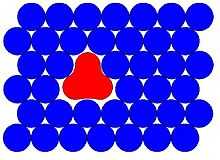Matrix isolation

Experiments

The transparent window, on to which the sample is deposited, is usually cooled using a compressed helium or similar refrigerant. Experiments must be performed under a high vacuum to prevent contaminates from unwanted gases freezing to the cold window. Lower temperatures are preferred, due to the improved rigidity and “glassiness” of the matrix material. Noble gases such as argon are used not just because of their unreactivity but also because of their broad optical transparency in the solid state. Mono-atomic gases have relatively simple face-centered cubic (fcc) crystal structure, which can make interpretations of the site occupancy and crystal-field splitting of the guest easier. In some cases a reactive material, for example, methane, hydrogen or ammonia, may be used as the host material so that the reaction of the host with the guest species may be studied.
Using the matrix isolation technique, short-lived, highly-reactive species such as radical ions and reaction intermediates may be observed and identified by spectroscopic means. For example, the solid noble gas krypton can be used to form an inert matrix within which a reactive F3- ion can sit in chemical isolation.[1] A species may be created chemically before deposition, or after by photochemical means. The technique may be used to simulate a species in the gas phase without rotational and translational interference. The low temperatures also help to produce simpler spectra, since only the lower electronic and vibrational quantum states are populated.

The reactive species can either be generated outside the apparatus and then be condensed, inside the matrix by irradiating or heating a precursor, or by bringing together two reactants on the growing matrix surface. For the deposition of two species it can be crucial to control the contact time and temperature. In Twin Jet deposition the two species have a much shorter contact time (and lower temperature) than in Merged Jet. With Concentric Jet the contact time is adjustable.[2]
History
Matrix isolation has its origins in the first half of the 20th century with the experiments by photo-chemists and physicists freezing samples in liquefied gases. The earliest isolation experiments involved the freezing of species in transparent, low temperature organic glasses, such as EPA (ether/isopentane/ethanol 5:5:2). The modern matrix isolation technique was developed extensively during the 1950s, in particular by George C. Pimentel.[3] He initially used higher-boiling inert gases like xenon and nitrogen as the host material, and is often said to be the "father of matrix isolation".
See also
- Host-guest chemistry
- Inert gases
- Van der Waals interactions
- Radicals
References
- ↑ Riedel. "Polyfluoride Anions, a Matrix-Isolation and Quantum-Chemical Investigation". Inorg. Chem. 41: 7156–7164. doi:10.1002/chin.201041002. Retrieved 2011-11-19.
- ↑ M.Clay, B.Ault (2010). J. Phys. Chem. A 114 (8): 2799–2805. doi:10.1021/jp912253t.
- ↑ Eric Whittle, David A. Dows, George C. Pimentel (1954). "Matrix Isolation Method for the Experimental Study of Unstable Species". The Journal of Chemical Physics 22 (11): 1943. doi:10.1063/1.1739957.
- Dunkin, Iain R (1998). Matrix-Isolation Techniques - A Practical Approach. Oxford: Oxford University Press. ISBN 0-19-855863-5.
- Daintith, John (senior editor) (2004). Oxford Dictionary of Chemistry. Oxford: Oxford University Press. ISBN 0-19-860918-3.
- Ball, David W., Zakya H. Kafafi, et al., A Bibliography of Matrix Isolation Spectroscopy, 1954-1985, Rice University Press, Houston, 1988
- NIST Optical Technology Division
- IUPAC Compendium of Chemical Terminology (Second Edition), 1997